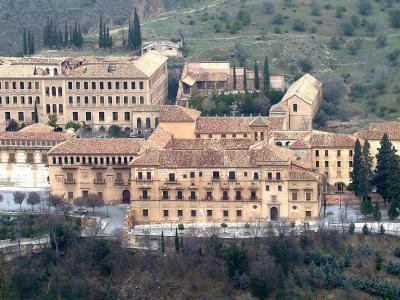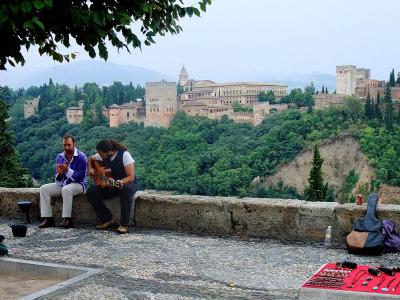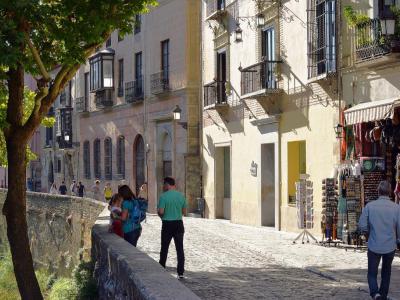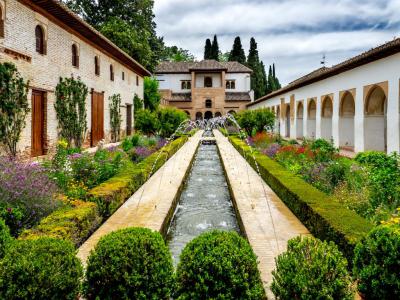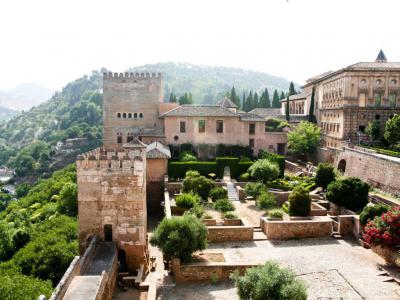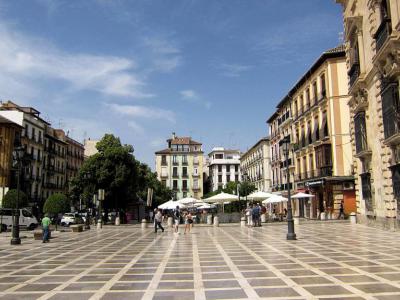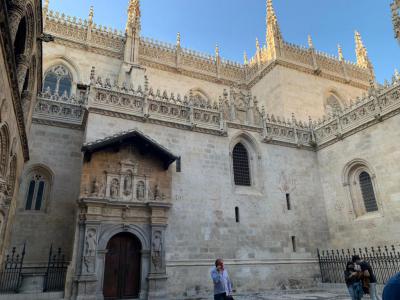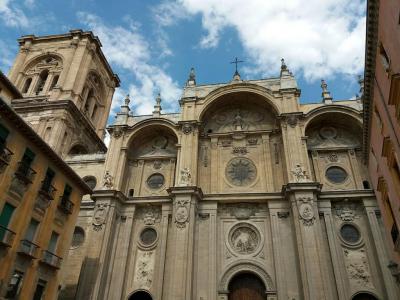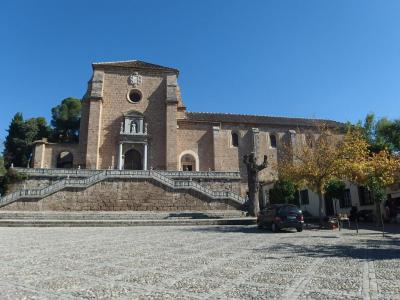Custom Walk in Granada, Spain by nladocsi_646dd created on 2025-03-20
Guide Location: Spain » Granada
Guide Type: Custom Walk
# of Sights: 10
Tour Duration: 3 Hour(s)
Travel Distance: 7.6 Km or 4.7 Miles
Share Key: H8EXA
Guide Type: Custom Walk
# of Sights: 10
Tour Duration: 3 Hour(s)
Travel Distance: 7.6 Km or 4.7 Miles
Share Key: H8EXA
How It Works
Please retrieve this walk in the GPSmyCity app. Once done, the app will guide you from one tour stop to the next as if you had a personal tour guide. If you created the walk on this website or come to the page via a link, please follow the instructions below to retrieve the walk in the app.
Retrieve This Walk in App
Step 1. Download the app "GPSmyCity: Walks in 1K+ Cities" on Apple App Store or Google Play Store.
Step 2. In the GPSmyCity app, download(or launch) the guide "Granada Map and Walking Tours".
Step 3. Tap the menu button located at upper right corner of the "Walks" screen and select "Retrieve custom walk". Enter the share key: H8EXA
1) Abadia del Sacromonte (Abbey of Sacromonte)
The Abbey of Sacromonte in Granada is a remarkable 17th-century religious and cultural institution located at the top of Mount Valparaíso, an area rich with historical and spiritual significance. This abbey is not only a residence for canons and a parish church but also houses an ecclesiastical museum, making it a focal point for both religious practice and cultural heritage.
The Abbey is famously associated with the discovery of the Lead Books in the 17th century. These artifacts, found under the church, contain texts that detail the martyrdoms of saints such as Saint Caecilius, Saint Ctesiphon, and Saint Hesychius. The catacombs beneath the church mark the site where Saint Caecilius, Granada's first bishop and patron saint, was martyred.
Architecturally, the Abbey features a blend of Mudejar and Renaissance styles. The church, designed by Juan de Maeda and completed in 1567, boasts exquisite Mudejar coffering in its central nave, transepts, and main chapel. The first of its ten chapels is noted for its Renaissance ceiling, a creation of Juan Vílchez. The church's entrance, crafted by Pedro de Orea, is a stunning example of Andalusian Renaissance art from the late 16th century.
A significant attraction within the Abbey is its museum, which was newly opened in February 2010. The museum is thoughtfully organized into four monographic rooms that showcase an impressive collection of art and historical manuscripts from the 16th and 17th centuries. This collection includes incunabula, codices such as those by San Juan de la Cruz, and noteworthy pieces like a copy of "The Chronicles of Nuremberg" by Hartmann Schedel, Ptolemy's World Map, and various Arabic manuscripts covering topics from religion to mathematics. Additionally, the museum displays Averroes' "Generalities on Medicine," along with an array of religious artifacts, tapestries, and ecclesiastical garments.
The Abbey is famously associated with the discovery of the Lead Books in the 17th century. These artifacts, found under the church, contain texts that detail the martyrdoms of saints such as Saint Caecilius, Saint Ctesiphon, and Saint Hesychius. The catacombs beneath the church mark the site where Saint Caecilius, Granada's first bishop and patron saint, was martyred.
Architecturally, the Abbey features a blend of Mudejar and Renaissance styles. The church, designed by Juan de Maeda and completed in 1567, boasts exquisite Mudejar coffering in its central nave, transepts, and main chapel. The first of its ten chapels is noted for its Renaissance ceiling, a creation of Juan Vílchez. The church's entrance, crafted by Pedro de Orea, is a stunning example of Andalusian Renaissance art from the late 16th century.
A significant attraction within the Abbey is its museum, which was newly opened in February 2010. The museum is thoughtfully organized into four monographic rooms that showcase an impressive collection of art and historical manuscripts from the 16th and 17th centuries. This collection includes incunabula, codices such as those by San Juan de la Cruz, and noteworthy pieces like a copy of "The Chronicles of Nuremberg" by Hartmann Schedel, Ptolemy's World Map, and various Arabic manuscripts covering topics from religion to mathematics. Additionally, the museum displays Averroes' "Generalities on Medicine," along with an array of religious artifacts, tapestries, and ecclesiastical garments.
2) Mirador de San Nicolas (San Nicolas Lookout) (must see)
Bill Clinton is supposed to have said "the most beautiful sunset in the world" when speaking of the sunset view from San Nicolas Lookout. San Nicolas does offer the best view of the Alhambra at sunset, but there are a lot of spectacular lookouts in Granada. San Cristobal is reputed to be a fantastic viewpoint of the City.
Each clear day at sunset there is a crowd gathering in the square of San Nicolas. They are there to watch the Alhambra turn red in the setting sun. Alhambra in Arabic means "red castle." Tourists, locals, and travelers come together at the overlook. There are vendors hawking snacks, flamenco dancers, souvenir sellers and other entertainments.
The lookout is named for San Nicolas Church and Square. The church was built on the top of a mosque in 1525. There seems to have been a trend, when the Catholic Monarchs took over in 1491, to drop a church on a mosque. Location, location, the man said. The church has been destroyed several times by fires, but the original bell tower survives.
For only a few euros it is possible to climb the tower San Nicolas and get a better view.
Each clear day at sunset there is a crowd gathering in the square of San Nicolas. They are there to watch the Alhambra turn red in the setting sun. Alhambra in Arabic means "red castle." Tourists, locals, and travelers come together at the overlook. There are vendors hawking snacks, flamenco dancers, souvenir sellers and other entertainments.
The lookout is named for San Nicolas Church and Square. The church was built on the top of a mosque in 1525. There seems to have been a trend, when the Catholic Monarchs took over in 1491, to drop a church on a mosque. Location, location, the man said. The church has been destroyed several times by fires, but the original bell tower survives.
For only a few euros it is possible to climb the tower San Nicolas and get a better view.
3) Carrera del Darro (Darro Street) (must see)
The whole left bank of the River Darro is called the Carrera del Darro. Carrera del Darro is unique in a city full of unique things. The street runs in between the river and the forest of Alhambra. At night the churches are lighted and the Alhambra at the top of its hill glows with light.
Starting in the sixteenth century the nobility of Granada made their homes in this picturesque place. Renaissance buildings, churches, and ruins beside bars and cafes line the street and the banks of the river. The Banuelo is here. Public baths came in the 11th century. Mudejar churches like Santa Ana and San Pedro date from 1567.
Then there is the tragic story of the House of Castril balcony. Today the Castril House is an archeology museum. It is a Renaissance dwelling built in 1539. It belonged to a rich nobleman named Zafra. Zafra was obsessive with keeping his daughter Elvira locked away from the local swains.
He ordered the death of a servant who was caught with a message for Elvira from a likely suitor. He believed the message of love was from the servant and ordered that he be hung from his daughter's balcony. When the servant protested his innocence, Zafra suggested he hang from the balcony and wait. Elvira took poison and killed herself.
There is an mysterious inscription that was found, "Esperando La Del Cielo" ("Waiting for Heaven") above Elvira's balcony. A melodramatic tragedy, the case was never solved.
Starting in the sixteenth century the nobility of Granada made their homes in this picturesque place. Renaissance buildings, churches, and ruins beside bars and cafes line the street and the banks of the river. The Banuelo is here. Public baths came in the 11th century. Mudejar churches like Santa Ana and San Pedro date from 1567.
Then there is the tragic story of the House of Castril balcony. Today the Castril House is an archeology museum. It is a Renaissance dwelling built in 1539. It belonged to a rich nobleman named Zafra. Zafra was obsessive with keeping his daughter Elvira locked away from the local swains.
He ordered the death of a servant who was caught with a message for Elvira from a likely suitor. He believed the message of love was from the servant and ordered that he be hung from his daughter's balcony. When the servant protested his innocence, Zafra suggested he hang from the balcony and wait. Elvira took poison and killed herself.
There is an mysterious inscription that was found, "Esperando La Del Cielo" ("Waiting for Heaven") above Elvira's balcony. A melodramatic tragedy, the case was never solved.
4) Paseo de los Tristes (The Promenade of the Sad) (must see)
Officially, the real name of Paseo de las Tristes is Paseo del Padre Manjon. The paseo was at one time a route for funeral processions. "Tristes" in Spanish can mean "sorrows." The paseo is easy to reach with the city's hop-on hop-off train or try a bus. When the weather is mild and clear the path is often crowded, especially at sunset.
The promenade is a pleasant walk bordered by the River Darro and some finer restaurants. There are stunning views of the Alhambra against the skyline. There is a flamenco venue (of course!) and tourist shops galore. The ancient cobblestone streets recall the medieval era.
The paseo leads to the San Jose cemetery, across the river and above the Alhambra. It was a long trip on foot for mourners. They must have stopped here, in this pleasant place to say their farewells. Today there is a spacious terrace with umbrellas from which to contemplate sunset views and have a drink and let go of the "sorrows".
The promenade is a pleasant walk bordered by the River Darro and some finer restaurants. There are stunning views of the Alhambra against the skyline. There is a flamenco venue (of course!) and tourist shops galore. The ancient cobblestone streets recall the medieval era.
The paseo leads to the San Jose cemetery, across the river and above the Alhambra. It was a long trip on foot for mourners. They must have stopped here, in this pleasant place to say their farewells. Today there is a spacious terrace with umbrellas from which to contemplate sunset views and have a drink and let go of the "sorrows".
5) Generalife Gardens (must see)
The name "Generalife" may be taken to mean "garden of paradise". It seems it was the dream of every Islamic gardener to create paradise in a garden. This theme can be seen in the gardens of the Alhambra, especially in the Generalife.
A promenade leads to the "Patio de la Acequia", the heart of the palace grounds. There is a gallery of arches on the western side. A portico on the north side is called the Mirador. The Mirador has five arches in front and three behind. Beyond the portico is the Patio de las Cipreses with a pool in the center.
A series of small pools are lined with oleander and myrtle shrubs. Go up a stone stairway to the Upper Gardens. The Upper Gardens were formerly olive groves. Today the former olive groves have an esplanade, and a stairway with cascading waterfalls. At the end there is a stage where the annual International Festival of Music and Dance is held.
The Spanish elite who moved into the palace installed long rows of fountains that would crash together in the air and splash into the central pool. The Spanish concept was a sharp departure from the Moorish style. The Moor loved a perfect garden, completely enclosed.
There are several legends about the Alhambra and the Generalife. One of the most intriguing concerns a Sultana and her lover, a knight of the opposition Abencerraje family. They rendezvoused beneath the branches of a great cypress, which is still alive today. They were found and the Sultan ordered all the men of that family to be killed.
The great Cypress, which is now called Cipres de la Sultana is waiting for them to return. War, romance, beautiful gardens, mosques and churches, what a mix!
Why You Should Visit:
This one of the few places in the world where the West and East commingle so well. They meet in architecture, history, culture, passion and civilization in the Alhambra.
Tips:
Go early as possible to have time and space. Go later and enjoy the sunsets. If considering staying at a parador, make a reservation well ahead.
A promenade leads to the "Patio de la Acequia", the heart of the palace grounds. There is a gallery of arches on the western side. A portico on the north side is called the Mirador. The Mirador has five arches in front and three behind. Beyond the portico is the Patio de las Cipreses with a pool in the center.
A series of small pools are lined with oleander and myrtle shrubs. Go up a stone stairway to the Upper Gardens. The Upper Gardens were formerly olive groves. Today the former olive groves have an esplanade, and a stairway with cascading waterfalls. At the end there is a stage where the annual International Festival of Music and Dance is held.
The Spanish elite who moved into the palace installed long rows of fountains that would crash together in the air and splash into the central pool. The Spanish concept was a sharp departure from the Moorish style. The Moor loved a perfect garden, completely enclosed.
There are several legends about the Alhambra and the Generalife. One of the most intriguing concerns a Sultana and her lover, a knight of the opposition Abencerraje family. They rendezvoused beneath the branches of a great cypress, which is still alive today. They were found and the Sultan ordered all the men of that family to be killed.
The great Cypress, which is now called Cipres de la Sultana is waiting for them to return. War, romance, beautiful gardens, mosques and churches, what a mix!
Why You Should Visit:
This one of the few places in the world where the West and East commingle so well. They meet in architecture, history, culture, passion and civilization in the Alhambra.
Tips:
Go early as possible to have time and space. Go later and enjoy the sunsets. If considering staying at a parador, make a reservation well ahead.
6) The Alhambra Palace and Fortress Complex (must see)
Alhambra in Arabic is "The Red One." It is a palace and fortress complex. It was originally built on the ruins of a Roman fortress in 889. It was rebuilt in the 13th century by the Muhammad I of Granada, the first ruler of the Emirate of Granada. It was converted to a palace by Yusuf I, Sultan of Granada. In 1492 it became the royal court of Ferdinand and Isabella.
The Alhambra was the place where Christopher Columbus received his commission to find the Indies which he never found. In 1526 Charles I of Spain ordered a Renaissance palace in the Mannerist style with its humanism contrasting with Nasrid architecture. After the decline of Nasrid influence, the Alhambra complex fell into neglect and disrepair.
Centuries later after Napoleon I had destroyed the site, the Alhambra was rediscovered. It is today one of the greatest tourist attractions in Spain. The Alhambra is a UNESCO World Heritage Site. It has been described by poets as a pearl in emeralds. This was a literal description of the colors of the stones imbedded in the surrounding woods.
The Alhambra park is stocked with nightingales. Running water from the fountains and cascades can be heard at all times. The idea was to create a kind of "paradise on earth." The exterior was made to be plain and austere.
The Alcazaba, also known as the old citidel, is the oldest part. All that is left are the great outer walls, towers and ramparts. Beyond the Alcazaba is the palace of the Arab rulers. There are the Nasrid Palaces of Alhambra and then the Alhambra Alta. originally meant for court officials.
The royal palace is of three parts. The Mexuar is plain and simple. It was for functions of business and government. Sersllo contains the Court of the Myrtles. The Harem is richly decorated. It was the living quarters for the wives and mistresses of the Sultan. It provided hot and cold running water, including showers.
Poets of the Nasrid period made poems for the Palace. Lines are inscribed in arches and columns in arabesque, cursive script. "There is no victor but God." appears often.
Why You Should Visit:
One should visit often in order to focus on the different places of interest. There are so many, all of them captivating. Don't travel thousands of miles to see a Spanish McDonald's. Visit to see what you can see nowhere else.
Tips:
Be prudent about crowds. There were cutpurses in Nasrid times, there are pickpockets now.
The Alhambra was the place where Christopher Columbus received his commission to find the Indies which he never found. In 1526 Charles I of Spain ordered a Renaissance palace in the Mannerist style with its humanism contrasting with Nasrid architecture. After the decline of Nasrid influence, the Alhambra complex fell into neglect and disrepair.
Centuries later after Napoleon I had destroyed the site, the Alhambra was rediscovered. It is today one of the greatest tourist attractions in Spain. The Alhambra is a UNESCO World Heritage Site. It has been described by poets as a pearl in emeralds. This was a literal description of the colors of the stones imbedded in the surrounding woods.
The Alhambra park is stocked with nightingales. Running water from the fountains and cascades can be heard at all times. The idea was to create a kind of "paradise on earth." The exterior was made to be plain and austere.
The Alcazaba, also known as the old citidel, is the oldest part. All that is left are the great outer walls, towers and ramparts. Beyond the Alcazaba is the palace of the Arab rulers. There are the Nasrid Palaces of Alhambra and then the Alhambra Alta. originally meant for court officials.
The royal palace is of three parts. The Mexuar is plain and simple. It was for functions of business and government. Sersllo contains the Court of the Myrtles. The Harem is richly decorated. It was the living quarters for the wives and mistresses of the Sultan. It provided hot and cold running water, including showers.
Poets of the Nasrid period made poems for the Palace. Lines are inscribed in arches and columns in arabesque, cursive script. "There is no victor but God." appears often.
Why You Should Visit:
One should visit often in order to focus on the different places of interest. There are so many, all of them captivating. Don't travel thousands of miles to see a Spanish McDonald's. Visit to see what you can see nowhere else.
Tips:
Be prudent about crowds. There were cutpurses in Nasrid times, there are pickpockets now.
7) Plaza Nueva (The New Square) (must see)
Despite its name, the Plaza Nueva (New Square) is one of the oldest squares in Granada. In former times the plaza was the scene of bull fights, tournaments and an occasional execution, definitely a spectator event. Before it was a square, however, it was a bridge. Called the Bridge of of Loggers, it spanned the River Darro.
The square is centrally located and is an ideal starting point for explorations on foot. Walk from the Puerto Granadas to the Alhambra forest to the Alhambra, a 15 or 20 minute journey. Exit by way of the cobbled street on the left of the Church of Santa Ana to the River Darro. Perhaps go up Elvira Street to the Mirador San Nicolas and the Albaicin.
The main attraction of the square itself is the High Court of Andalusia. The court building was formerly the Chancilleria Real (Royal Chancellery). Construction of the Chancellery began in 1530. In the rear of the building a prison, handy to the court. The square is also home to the Arborea Flamenco. Cafes, flamenco, ole!
The square is centrally located and is an ideal starting point for explorations on foot. Walk from the Puerto Granadas to the Alhambra forest to the Alhambra, a 15 or 20 minute journey. Exit by way of the cobbled street on the left of the Church of Santa Ana to the River Darro. Perhaps go up Elvira Street to the Mirador San Nicolas and the Albaicin.
The main attraction of the square itself is the High Court of Andalusia. The court building was formerly the Chancilleria Real (Royal Chancellery). Construction of the Chancellery began in 1530. In the rear of the building a prison, handy to the court. The square is also home to the Arborea Flamenco. Cafes, flamenco, ole!
8) Capilla Real de Granada (Royal Chapel) (must see)
When Queen Isabella moved into Granada, she was a woman who had found her new home. She was determined to fix it up, to make it her own. Among the first things on her list was to make an addition to that new cathedral that was sitting on the old mosque. The add-on would be her very own chapel, not a little one either. It would be her Main Chapel.
The Main Chapel was constructed at last by 1517. It was built in the new Isabelline style. It is a transition from Gothic to early Renaissance architecture. Isabella planned to stay. By royal decree the chapel was declared to be the future burial site for herself and King Ferdinand. The King did not object.
The chapel is dedicated to Saint John the Baptist and Saint John the Evangelist. The interior is reminiscent of the Monastery of San Juan de los Reyes in Toledo. It has four side chapels in the form of a cross and a Gothic vault. In the center of the transept are the tombs of Isabella and Ferdinand. The tombs are sculpted and raised.
Spoiler alert. The tombs are empty. The royal remains are actually in the crypt below. Since the church is still used for services, the crypt is not always open to visitors. The Catholic kings and queens are joined in this chapel. Their memorials mark the emergence of the coming power and glory of Spain and the brilliant renaissance of Europe.
The Main Chapel was constructed at last by 1517. It was built in the new Isabelline style. It is a transition from Gothic to early Renaissance architecture. Isabella planned to stay. By royal decree the chapel was declared to be the future burial site for herself and King Ferdinand. The King did not object.
The chapel is dedicated to Saint John the Baptist and Saint John the Evangelist. The interior is reminiscent of the Monastery of San Juan de los Reyes in Toledo. It has four side chapels in the form of a cross and a Gothic vault. In the center of the transept are the tombs of Isabella and Ferdinand. The tombs are sculpted and raised.
Spoiler alert. The tombs are empty. The royal remains are actually in the crypt below. Since the church is still used for services, the crypt is not always open to visitors. The Catholic kings and queens are joined in this chapel. Their memorials mark the emergence of the coming power and glory of Spain and the brilliant renaissance of Europe.
9) Granada Cathedral (must see)
Granada Cathedral is a Roman Catholic church. It is the seat of the Archdiocese of Granada and it was built on top of the bones of the Mosque of the City. The construction took place in 1518 after the Christian Reconquest of Andalusia.
The Cathedral was started in The Spanish Renaissance style rather than the Gothic. In 1523 the first architect, Enrique Egas was replaced by Diego de Siloe. The work continued for forty years. Diego planned for a triforium of five naves rather than three. His principal chapel (capilla mayor) was circular, not a semicircular apse.
For 181 years alterations and revisions proceeded under different architects until 1667. Alonso Cano and Gaspar de la Pena introduced Baroque elements to the facade. In 1699 after 181 years, this document of stone might be considered almost complete. But two high towers were planned and never built. The ground underneath was considered unstable.
The Cathedral was meant to be the royal mausoleum but Philip II moved the royal burial site to the palace of El Escorial near Madrid.
The Cathedral was started in The Spanish Renaissance style rather than the Gothic. In 1523 the first architect, Enrique Egas was replaced by Diego de Siloe. The work continued for forty years. Diego planned for a triforium of five naves rather than three. His principal chapel (capilla mayor) was circular, not a semicircular apse.
For 181 years alterations and revisions proceeded under different architects until 1667. Alonso Cano and Gaspar de la Pena introduced Baroque elements to the facade. In 1699 after 181 years, this document of stone might be considered almost complete. But two high towers were planned and never built. The ground underneath was considered unstable.
The Cathedral was meant to be the royal mausoleum but Philip II moved the royal burial site to the palace of El Escorial near Madrid.
10) Monastery Cartuja (must see)
The Monastery Cartuja in Granada (Monasterio de la Cartuja) stands as an example of Spanish Baroque architecture. Founded in 1506, the monastery's construction commenced in 1516 and stretched over the next three centuries, reflecting a prolonged period of architectural evolution and embellishment. This extensive period allowed for the incorporation of Gothic and Renaissance styles, which can be seen in the intricate details and finishes throughout the structure.
While the exterior of the monastery presents a stark and austere façade, the interior tells a different story. It is an exuberant showcase of Churrigueresque style, noted for its flamboyant ornamentation and complex, geometric surfaces. Key features of the interior include the tabernacle, designed by Francisco Hurtado Izquierdo, and the church and sacristy, the latter of which was constructed between 1727 and 1764 by Luis de Arévalo and F. Manuel Vasquez. These elements highlight the dramatic and decorative richness that characterizes much of Spanish Baroque architecture.
The monastery also houses an extensive and valuable collection of paintings, prominently featuring works by Fray Juan Sánchez Cotán. Additionally, nearby church structures enhance the artistic appeal of the site with exquisite marble sculptures and notable paintings by Juan Sánchez de Cotán and a special ceiling painting by Palomino in the sacrament's tower.
The monastery's location on a northern hill outside the central area of Granada lends it a peaceful atmosphere, slightly removed from the typical tourist paths. Despite this, it remains a worthy destination for those visiting the city, particularly appealing for its quietude and architectural splendor.
Historically, the Monastery Cartuja was inhabited by Carthusian monks until 1835. These monks followed strict practices of silence and fasting, dedicating their lives predominantly to prayer and living largely as hermits within the monastery's confines.
The Monastery Cartuja not only serves as a historical and cultural landmark but also stands as a serene retreat from the bustling city center of Granada, offering visitors a glimpse into Spain’s rich religious and architectural heritage.
While the exterior of the monastery presents a stark and austere façade, the interior tells a different story. It is an exuberant showcase of Churrigueresque style, noted for its flamboyant ornamentation and complex, geometric surfaces. Key features of the interior include the tabernacle, designed by Francisco Hurtado Izquierdo, and the church and sacristy, the latter of which was constructed between 1727 and 1764 by Luis de Arévalo and F. Manuel Vasquez. These elements highlight the dramatic and decorative richness that characterizes much of Spanish Baroque architecture.
The monastery also houses an extensive and valuable collection of paintings, prominently featuring works by Fray Juan Sánchez Cotán. Additionally, nearby church structures enhance the artistic appeal of the site with exquisite marble sculptures and notable paintings by Juan Sánchez de Cotán and a special ceiling painting by Palomino in the sacrament's tower.
The monastery's location on a northern hill outside the central area of Granada lends it a peaceful atmosphere, slightly removed from the typical tourist paths. Despite this, it remains a worthy destination for those visiting the city, particularly appealing for its quietude and architectural splendor.
Historically, the Monastery Cartuja was inhabited by Carthusian monks until 1835. These monks followed strict practices of silence and fasting, dedicating their lives predominantly to prayer and living largely as hermits within the monastery's confines.
The Monastery Cartuja not only serves as a historical and cultural landmark but also stands as a serene retreat from the bustling city center of Granada, offering visitors a glimpse into Spain’s rich religious and architectural heritage.
